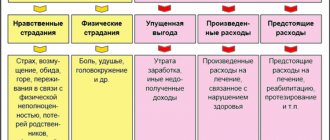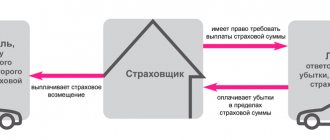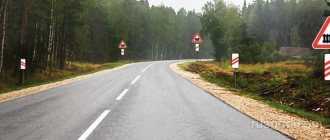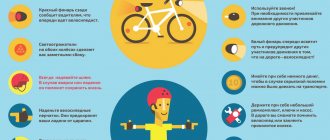| 12.15 Part 1 of the Code of Administrative Offenses of the Russian Federation. Violation of the rules for placing a vehicle on the roadway, oncoming traffic, as well as driving along the side of the road or crossing an organized transport or pedestrian convoy or taking a place in it | Fine from 1,000 to 1,500 rubles. |
| 12.15 Part 3 of the Code of Administrative Offenses of the Russian Federation. Driving, in violation of the Traffic Rules, into a lane intended for oncoming traffic when avoiding an obstacle, or onto tram tracks in the opposite direction when avoiding an obstacle | Fine from 1,000 to 1,500 rubles. |
| 12.15 Part 4 of the Code of Administrative Offenses of the Russian Federation. Traveling, in violation of the Traffic Rules, onto a lane intended for oncoming traffic, or onto tram tracks in the opposite direction, except for the cases provided for in Part 3 of this article | Fine 5,000 rubles. or deprivation of the right to drive a vehicle for a period of 4 to 6 months. |
| 12.15 Part 5 of the Code of Administrative Offenses of the Russian Federation. Repeated commission of an administrative offense provided for in Part 4 of this article | Deprivation of the right to drive a vehicle for a period of 12 months or a fine of 5,000 rubles. (in case of recording by automatic means of photo and video recording) |
| 12.16 part 1 of the Code of Administrative Offenses of the Russian Federation. Failure to comply with the requirements prescribed by road signs or markings of the roadway, except for the cases provided for in parts 2 - 7 of this article and other articles of this chapter | Warning or fine 500 rubles. |
In our opinion
The situation with road accidents leaves much to be desired. The authorities have done a lot in recent years to restore order on the country's roads. Unfortunately, these measures are not enough - the number of accidents has not decreased significantly. Naturally, the human factor plays a role here. The thing is that in our country there is a very low driving culture and a sense of responsibility towards others.
See also Rules for safe driving in rainy weather
Also, our simple Russian language often leads to stupid accidents with serious consequences. So it would not hurt many motorists to stop scolding the state for the dominance of traffic police cameras on the road, for increasing administrative liability for a number of traffic violations, and first of all, look at themselves from the outside. Maybe, in order to restore order on the roads, we first need to stop breaking traffic rules ourselves?
Now let's look at the most common questions that drivers ask on the Internet:
How to overtake correctly?
When you first start learning to drive an automatic or manual car, the most difficult element for you will most likely be overtaking. And, truly, this is one of the moments when you interact with other road users and should be as focused as possible on the road. In addition, there are many nuances in overtaking that only a professional driver can explain to you.
Sometimes you look at the behavior of drivers on the road and want to ask - “advise a driving instructor”, maneuvers and overtaking are carried out so well and correctly. However, you, too, can easily become such a person if on the road you think not only about your convenience and speed, but also about those who are driving next to you. First of all, before changing into the desired lane or even into the oncoming lane, carefully assess the situation on the road. There should be no cars or other obstacles ahead that could interfere with you. Remember, a good overtaking should take no more than 5 seconds, so do not plan to overtake several cars at once, it is quite possible that the situation on the road will change during this time, and they will not have time to let you back into the lane or will not want to because of the danger.
“Peek out” a little from behind the car in front and, if the road is clear, squeeze the gas and enter the overtaking lane. Do not forget to indicate the maneuver with the left turn signal before doing this. Now accelerate until the next car is left behind. Return to your lane and reduce your speed to a comfortable speed. If you see that there are no other vehicles ahead, then you still shouldn’t turn off the turn signal until the maneuver is completely completed; those driving behind you will understand that there is still time to overtake not only your car. Thus, you will become a friendlier and better driver, increasing your status in the eyes of other drivers.
Traditionally, drivers who are being overtaken will try to move slightly to the right to make it easier for you to maneuver. But these are good drivers, and there are also plenty of inadequate ones on our roads. What to do in such cases? Be careful, there are many motorists on the road who “indulge” in the fact that while overtaking they also begin to accelerate, thereby not letting you pass ahead. If you are a beginner, then, naturally, at first this causes a slight panic. Just carefully slow down, make sure that no one has taken your place behind the “racer”, and get back into your lane. This will significantly simplify your movement and prevent a stressful situation from forming, and the maneuver can be done later, after all, your own safety is more important.
Try, especially when you get into a car for the first time, when you still feel unsure behind the wheel, not to overtake large cars. After all, trucks, trucks, and cars with trailers create a large “blind” zone, which is why it is quite possible to get into an accident. You cannot overtake cars at high speed in the heat. The asphalt is hot, the tires are hot, and during overtaking the tire can burst, and this in almost one hundred percent of cases will lead to an accident with several participants.
| Tweet |
Is it possible to overtake trucks in places where there is a “No Overtaking” sign?
Russian legislation does not prohibit overtaking heavy vehicles, trucks and other vehicles, unless it is expressly prohibited by road markings, road signs and other traffic rules. But many people ask what to do if a truck or tractor is driving at a slow speed on a road where overtaking is prohibited, collecting a whole line of vehicles behind it.
According to the traffic rules, road sign 3.20 “Overtaking is prohibited” states that on the section of the road where it is installed, overtaking of all vehicles is prohibited, except for slow-moving vehicles, horse-drawn carts, bicycles, mopeds and two-wheeled motorcycles without a side trailer.
What is a low-speed vehicle? According to traffic regulations, a low-speed vehicle is a mechanical vehicle whose design speed does not exceed 30 km/h. Slow-moving vehicles must have a special sign (equilateral red triangle with yellow border). So, if you see a truck or tractor with such a sign, even if there is a “No Overtaking” sign, you can overtake.
If there is a truck, truck, etc. in front of you that is not a slow-moving vehicle, overtaking can only be done in places where it is permitted by markings and road signs.
By the way, do not forget that if you see a road sign “Overtaking is prohibited” and a solid marking line, overtaking a slow-moving vehicle is allowed. If there is no sign, but there is a solid marking line 1.1 or 1.11, overtaking a slow-moving vehicle is prohibited.
Tips for drivers
Overtaking can indeed be dangerous, and some drivers are afraid to do it. But this is completely in vain, because in order for this maneuver not to lead to consequences, you need to know some rules and tips, which will be discussed below. It is important to note that the basic rules on how to overtake are prescribed in the traffic rules, and every driver should know them. Of course, these rules must be followed, because this is the basis.
But there are also a number of tips that will help make overtaking on the highway as safe as possible.
- First, if you are on the highway and intend to overtake a vehicle, make sure it is not prohibited and there are no signs on the road.
- Secondly, it is necessary that the oncoming lane is completely clear and there are no cars on it.
- Third, you need to turn on your turn signal so that other vehicles on the road understand that you are about to overtake.
- Fourthly, then you need to drive into the oncoming lane, your speed should be 10-20 km higher.
- Fifthly, if you are overtaking, then you need to be prepared for the fact that a car may appear in the oncoming lane at any moment. In this case, you should have the opportunity to go back, and you should do this immediately.
Is it possible to overtake cars with special signals?
According to clause 3.2 of the Russian Federation Traffic Regulations, drivers are prohibited from overtaking vehicles that have special color schemes on the outer surface of the body, as well as a blue flashing light and a special sound signal.
In particular, it is prohibited to overtake vehicles that have special color schemes on them, with blue and red flashing lights turned on and a special sound signal, as well as the vehicle (accompanied by them).
Please note: the ban on overtaking special vehicles only applies if the car actually has color graphics on the body, a beacon and a special sound signal are turned on. If, for example, there is no sound signal, overtaking is allowed.
Is it possible to overtake a car with a blue special signal on if there are no special color schemes on the body? Yes, in this case, according to traffic regulations, overtaking is allowed, since this car, although equipped with a special signal, is not a special vehicle.
Also remember that overtaking is different from ahead. So it’s possible to get ahead of special vehicles that have color schemes, an activated beacon and an audible signal.
What is the penalty for crossing a double solid line on the road when overtaking?
Very often, drivers violate existing road markings on the road, which leads to accidents. The issue of crossing a double solid line when overtaking in the wrong place, prohibited by traffic regulations, is especially acute.
Many drivers not only forget about the serious responsibility for this type of violation, but also do not realize the real danger for all road users. Do not forget that the Rules of the Road are essentially written in blood, and road markings on certain sections of the road appeared for a reason.
First, let's remember what a “double solid” is:
Markup 1.3:
Crossing this marking is strictly prohibited!
These markings separate traffic flows in opposite directions on roads with four or more lanes. Also, double continuous markings are applied to roads with two or three lanes - with a lane width of more than 3.75 meters. That is, when moving next to a double solid line, if you cross it, you enter the oncoming lane, for which Russian legislation has administrative liability in accordance with Part 4 of Article 12.15 of the Code of Administrative Offenses of the Russian Federation - a fine of 5,000 rubles or deprivation of rights for a period of 4 to 6 months.
The legislation also provides for liability for repeated violations, provided for in Part 5 of Article 12.154 of the Code of Administrative Offenses of the Russian Federation. In this case, the driver will be deprived of his license for 1 year. However, if this violation was recorded by a complex of photo and video recording of traffic violations, the driver faces a fine of 5,000 rubles. A repeated violation is considered if the traffic rules are violated within a year from the date of the last offense.
What mistakes do drivers make when overtaking?
The most common mistake made when overtaking is not having enough space in the oncoming lane, that is, there are cars nearby. Unfortunately, drivers think that they will have time to overtake and make such a mistake. In this situation, it is not always possible to overtake, and this cannot be ignored. By the way, drivers can help each other.
If someone wants to overtake you on the road, and you see that there is a car ahead, then simply turn on your headlights so that the other driver understands that overtaking now is not the best solution. It's nothing for you, but the other driver will be grateful to you. You need to be polite on the road, and then driving cars will become much safer, even on the busiest roads, which is good news.
So, we talked in more detail about overtaking vehicles, and now it has become clear that doing this is not so difficult, but for this you need to know some rules and tips, all of them have been discussed here. If you follow these rules, you will feel calm and easy on any route. You just have to be more careful on the road and understand that this is a place of increased danger.
Is it possible to overtake a cyclist?
Let us remind you that a bicycle is a vehicle, therefore, when overtaking it, you must strictly comply with the current Rules of the Road. Accordingly, if you violate current traffic rules when overtaking a cyclist, you will face administrative liability. For example, if you cross a double line when overtaking a cyclist, you will be charged under Article 12.15 of the Code of Administrative Offenses of the Russian Federation. However, let us remind you that in some cases you are allowed to overtake a cyclist even in places where overtaking is prohibited. The rules for overtaking a slow-moving vehicle, which is a bicycle, apply here.
Overtaking/getting ahead at an intersection: when is it possible?
It is known that overtaking at the intersection is prohibited. It is also prohibited to overtake if the car in front has turned on its left turn signal. Look at the situation in the picture. This maneuver of the blue car is allowed, since it is not considered overtaking (see above for what overtaking is). This example shows the advance of a car that, having turned on its turn signal to the left, is about to turn. There is no legal responsibility for the maneuver of a blue car.
How to overtake correctly on the highway?
Details Category: Driving school Published 10/20/2019
Some tips for novice drivers on how to properly overtake a car on the highway.
Overtaking a car is one of the most dangerous driving maneuvers. Mistakes while overtaking in the oncoming lane always end sadly.
Formally, the basic requirements for overtaking are specified in the traffic rules. However, in addition to them, there are points that are dictated by the real road situation, and which must be taken into account when overtaking.
So, an ideal overtaking should look like this:
- Having caught up with a passing car on the highway, you need to make sure that overtaking is not prohibited by road signs and markings, the oncoming lane is clear at a distance sufficient for overtaking, and no one is overtaking us.
- Turn on the turn signal, accelerate in your lane so that the speed is at least 10-20 km/h higher than the speed, and drive into the oncoming lane
- At the moment we start overtaking, before we have caught up with the rear bumper of the front car, we need to be prepared, if an oncoming car appears, to return to our lane
- If there are no obstacles, we accelerate as much as possible and overtake the car.
- Before we return to our lane, we need to make sure that we do not interfere with the car being overtaken.
One of the common mistakes when overtaking is a small distance to the overtaken vehicle. It is safer to overtake a car without pressing close to it. If the distance is small, then each time, in order to see the situation on the oncoming lane, you will have to “stick” the car almost half out of its lane. At a long distance, it will be enough to just move to the left, towards the marking line, to get a good overview.
The second mistake is too little speed when overtaking. When overtaking, the time spent in the oncoming lane should be minimal. Therefore, you need to make the most of the dynamic capabilities of the car. For cars with low power, it is optimal to switch to a lower gear before overtaking to improve acceleration.
To reduce the time spent in oncoming traffic, a greater distance to the overtaken vehicle is also useful. Using it, acceleration can be accomplished almost entirely in your own lane, and you can drive into oncoming traffic with the required speed reserve.
Don’t forget the main rule of overtaking: “If you’re not sure, don’t overtake!”











